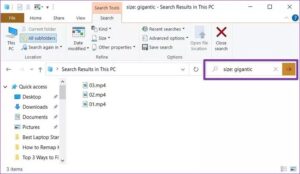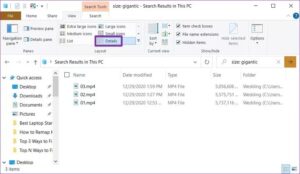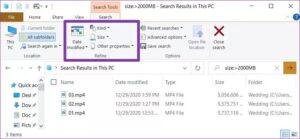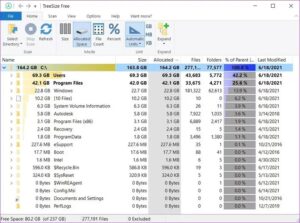This post will explain find large files Windows. On a regular basis, your PC would lack storage or reach near capacity. They could be the big multimedia or unused files or a bunch of the leftover files from the software application you uninstalled months ago. However, looking for big files on your Windows 10 computer is simpler said than done.
Top 3 Ways To Find Large Files On Windows 10
In this article, you can know about find large files Windows here are the details below;
You can make use of the integrated tools inside Windows or use third-party alternatives to find those large files monopolizing up space on your Windows 10 PC. Apart from finding, you can also manage big files efficiently. Also check Windows 10 dark mode File Explorer.
1. Usage File Explorer
Probably the easiest method to discover large files on your PC is using File Explorer. It allows you to rapidly look for large files in a specific drive or a folder with a couple of sorting alternatives. Here’s how to do it.
Step 1: Press Windows secret + E to rapidly release the File Explorer. Navigate to This PC to explore your entire COMPUTER for large files. Likewise, you can also go to a particular folder or drive to narrow down your search.
Step 2: To include the concealed files in your search engine result, go to the View tab, and tick the checkbox that reads ‘Surprise products’.
Step 3: Now head over to the research toolbar in the leading right corner. Enter size: gigantic and hit Go into. This will show you records larger than 128MB in size.
Similarly, you can return enormous in the above command with other options such as Empty (0 KB), Tiny (0– 10 KB), Small (10– 100 KB), Medium (100 KB– 1 MB), Big (1– 16 MB), and Substantial (16– 128 MB) to filter your search appropriately. Alternatively, you can also transcribe in a command like size: > 250MB in the research box to look for data less than or more than a particular size. Also check X570S AORUS Master.
Step 4: To view extra info about each item, go to the View tab at the top and select Information in the Layout box.
Step 5: Change to the Browse tab to filter your search by file size. Likewise, you can use the Kind, Date customized, and Other residential or commercial properties option also.
Additionally, you can conserve the search results page for later by utilizing the ‘Conserve search’ alternative at the top.
Keep in mind: While searching for big files, if you discover a file or folder that you don’t acknowledge, do not erase it without knowledge as it may be an essential part of the Windows os.
2. Utilize the Command Prompt
Another method to discover big files on Windows is through Command Trigger. Running a command will fetch you a record of data greater than the defined size saved on your PC. Here’s how.
Step 1: Press Windows + R to open the Run dialog. Key in cmd and hit Enter.
Step 2: Type the command pointed out listed below and press Get in.
FORFILES/ S/ C “cmd/ c and @fsize GTR 1048576 echo @path”
Note: In the above company, 1048576 represent 1MB (1024 * 1024 = 1048576 bytes). You can modify that number accordingly to look for files greater than the discussed number.
As seen in the image, the command trigger will reveal you areas of files larger than 1MB in size.
3. Use a Third-Party Tool
While the inbuilt options to discover large files work just great, you can use dedicated third-party software to evaluate your storage further and find big files with ease. One such popular software is TreeSize. This tool lets you view area occupied by files and folders at a glimpse with a lot of other file management choices as well. Also check how to recover deleted files in windows 10 8 7.
After it downloads, open the TreeSizeFreeSetup.exe data including follow the on-screen guidelines to set up TreeSize on your PC. Make sure to provide TreeSize the admin authorizations to scan all folders to find big files.
Here the primary screen will reveal you folder details, including the space occupied by each file or folder. At the top, you’ll get choices to switch modes, change size systems, sorting options, & more. Additionally, TreeSize also lets you delete and compress files right from the home screen.
TreeSize likewise has a couple of paid versions available for individual and professional use, unlocking additional perks such as flexible file search, replicate finder, deduplication, and more.
Discover Files at Large
So these were the best methods to discover large files on Windows. Finding big files is a reliable method to eliminate unused files or move them to cloud storage to free up area on your PC. Also check how to send large files free.
If you’re looking to maximize disk space without deleting any of your important information, attempt erasing cache files on Windows to maximize important storage space.








